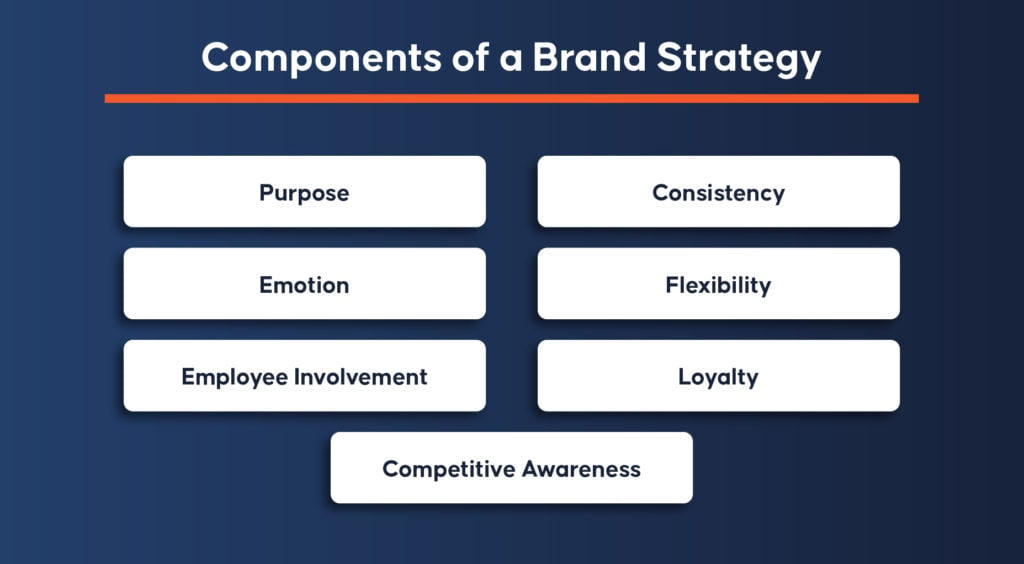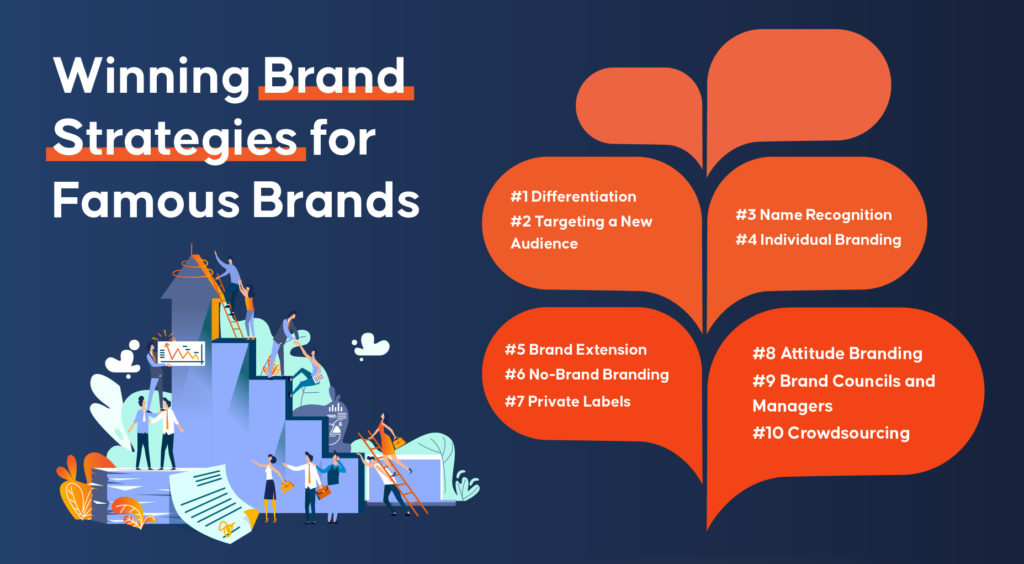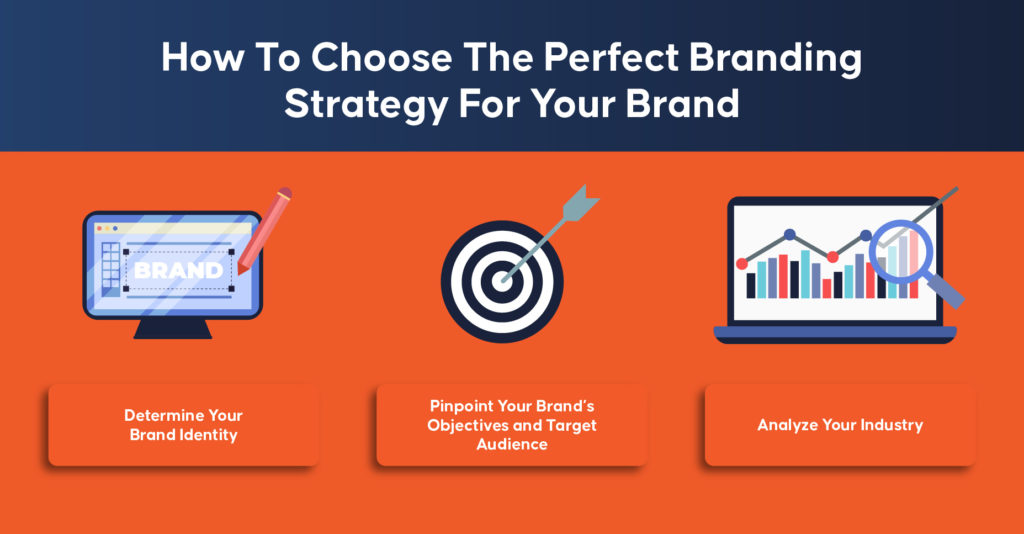Inquivix HQ
1-903, 18 Eonju-ro 146-gil,
Gangnam-gu, Seoul, Korea
06057

Every company aims to build its unique identity and stand out from the competition. That is why they want to build a brand where customers would recognize the business by a logo, slogan, or even just a simple color scheme. Developing a brand identity and a brand story is essential for successful marketing efforts. There are a variety of different marketing strategies that a famous brand can use in order to reach consumers. However, each strategy has its own set of pros and cons, and it can be difficult to determine which is the best option for a particular brand.
What Is a Brand Strategy?
Before identifying which strategy to use, let’s take a look at what is a brand strategy. Simply put, a brand strategy is a long-term plan that outlines how a company wants to present itself to consumers. It aids companies in building a specific perception among existing and potential consumers. Customers will connect with a company’s brand and what it does without being told who the firm is after it has implemented a successful brand strategy.
Successful branding strategies should be well-designed and carried out at all company operations with the goal of enhancing financial performance, competitive advantage, and customer experience. It includes the goals that the company hopes to achieve, as well as the tactics it will use to achieve them. Businesses should first establish corporate objectives that they want to achieve by launching the brand when developing a strong brand strategy. They should also determine the target audience, which will aid in the branding’s success.
Components of a Brand Strategy
Your brand is more than just your product, logo, or even website. A brand is intangible, yet it’s one of the most important assets a company has. It represents the sum of all customer impressions and experiences with your products and services. Building a brand is more of an art than a science. A brand strategy process has many steps to take into consideration. Let’s take a look at what makes up a comprehensive brand strategy.

Purpose
When defining your brand positioning, it’s critical to understand what your company promises, but because your purpose serves as a differentiator between you and your competition. It has to be specific. Your business’s purpose has two aspects; functional and intentional. The notion of functionality is concerned with evaluating outcomes in terms of immediate and business reasons. A company’s ability to be successful financially while simultaneously making a positive impact on the world is referred to as intentionality.
Consistency
The secret to consistency is to avoid discussing anything that doesn’t pertain to or build on your brand. You need to make certain that all of your brand messaging is coherent in order to provide your company a platform to stand on. Being consistent contributes to brand recognition and consumer loyalty. Consider the advantages of creating a style guide to assist potential consumers avoid having difficulties putting your company’s disconnected pieces together. A style guide may cover everything from the brand voice to the color scheme you’ll choose to how you’ll arrange specific items or services.
Emotion
People are naturally interested in forming connections. They seek belongingness; the need for love, care, and inclusion in groups. Find a method to engage your consumers on a more emotional level. Do you offer them assurance? Make them feel as if they are a part of the family? Do you make their lives simpler? Use emotional cues like these to strengthen your connection and foster loyalty.
Flexibility
Marketers must be nimble in this rapidly changing environment to remain competitive. This allows you to be more creative with your branding. While consistency sets the bar for your business, flexibility lets you modify elements that increase interest and distinguish your strategy from that of the competition. So, if your prior strategies are no longer yielding the results you desire, don’t be afraid to alter them. It doesn’t matter whether it worked in the past; what matters is whether it’s working right now. Take advantage of the opportunities to interact with your consumers in innovative ways. Is there anything new you can do with your brand’s existing partnerships? Are there any aspects of your goods that you’ve never highlighted? Use those as a means to connect with new consumers and remind existing ones why they like you.
Employee Involvement
Employees are representatives of your business and how they interact with customers affects your brand. It’s critical for your staff to be well-versed in both how they should interact with clients and how they should represent the company. It can develop a solid reputation for trustworthy, helpful, and personable customer service by requiring all personnel to adhere to the company’s fundamental principles. The employees should represent the brand just like the brand represents the company.
Loyalty
Reward those customers that love you, your company, and your brand. Customers like these have gone out of their way to praise you, spread the news about you, and become your brand ambassadors. You’ll be able to earn back more repeat customers and increased earnings for your business by developing loyalty from these individuals. Sometimes all that is required is a simple thank you. On other occasions, it’s best to go above and beyond with a gift or some other recognition. The way you express a good connection between you and your present customers provides the foundation for what prospective consumers may anticipate if they choose to do business with you.
Competitive Awareness
Take the competition as a challenge to devise your own approach and provide more value to your whole brand. If you’re in the same line of business, target the same consumers, and are competing for the same revenue, keep an eye on what they do. See which of their strategies succeed or fail. Adapt your brand’s positioning to improve your company. While keeping up with your competitors’ plans is beneficial for brand improvement, don’t let them control every aspect of your operation. Make sure to keep your identity and differentiate yourself from the competition.
What is Brand Awareness?
Brand awareness is how consumers identify and remember your company. The more brand awareness you possess, customers are more likely to remember your logo, messaging, and products. It’s a term to describe how aware and informed your customers are about what you have to offer.
Why Is Brand Awareness Important?
Brand awareness is crucial since it aids customers in understanding, remembering, and feeling familiar with your branding and products. Brand awareness will help your brand become the first choice for consumers when they are researching products and buying. This will help your brand to turn into a successful business.
Top 10 Winning Brand Strategies for Famous Brands
There are a variety of different marketing strategies that a famous brand can use in order to reach consumers. However, each strategy has its own set of pros and cons, and it can be difficult to determine which is the best option for a particular brand. In some cases, a brand might need to employ multiple strategies in order to achieve maximum success. Here are the top 10 winning brand strategies you can utilize.

#1 Differentiation
Differentiation is the first thing that springs to mind when it comes to branding. This is an effective brand strategy because it allows companies to focus on a certain audience while also conveying the sense that they are speaking directly to them. Differentiation for some businesses may be defined as providing higher quality than that of their rivals. Another approach to differentiate is through brand voice. Two firms may provide almost identical services, but one uses a serious tone while the other uses a lighthearted one.
#2 Targeting a New Audience
This is a successful brand strategy that has been used for decades or more without much change. A brand can come up with a completely new approach to a traditional product/service and attract a new audience. The banking sector is a good example. They quickly adapted to the digital era with internet banking and mobile apps to attract digital natives.
#3 Name Recognition
The most well-known brands make their money by relying mainly on their name to entice consumers to try new goods and services. These are the types of companies that most consumers recognize just by their logo, slogan, or color scheme.
#4 Individual Branding
A business may want to establish a unique brand for a product line in order to give it its own identity. This is beneficial if the company’s product range has a particular demographic or distinct features from the whole organization.
#5 Brand Extension
Individual branding, on the other hand, is the opposite approach of brand extension. When a firm has built a brand to sell one specific product and decides to branch out into new markets, this is known as market extension. The company benefits from the consumer’s existing connection to the original brand.
#6 No-Brand Branding
It may seem paradoxical, but the no-brand strategy is one type of brand strategy. These generic goods appeal to customers because they can spend less while still obtaining a quality product. This creates fierce competition with branded products when the company produces generic but quality products that consumers can rely on.
#7 Private Labels
Another way businesses are capitalizing on people’s desire for generic goods is through private labels. This is when a brand licenses a manufacturer to make an item and then puts its own label on it. This is beneficial for businesses because it allows them to develop their own product range in order to compete with those they sell. As a result of the increasing proportion of profits from private-label items, they can keep costs low. A lot of supermarkets follow this marketing strategy.
#8 Attitude Branding
A business uses attitude branding to create a feeling about the company in addition to its products and services. This great brand strategy distinguishes the brand’s personality and represents a lifestyle customers would want to be associated with. It’s a smart way to involve consumers in your branding.
#9 Brand Councils and Managers
Some organizations have a full team dedicated to brand management. It’s also known as a brand council and is made up of senior executives from throughout the company, including HR, legal, marketing, and finance. It might also include the CEO and outside advisors. Although large companies are more likely to have a brand council, this approach is advantageous for midsize and even small firms, the alternative being employing just a brand manager. The person in this post is committed to ensuring that the brand’s mission and goals are satisfied by monitoring markets, trends, and revenue. Different managers are assigned to each brand when there are several distinct individual brands inside the same business. Of course, you may also utilize both techniques at the same time. A brand council is in charge of monitoring, while the brand manager is responsible for implementation.
#10 Crowdsourcing
Many organizations utilize crowdsourcing for a variety of purposes, including brand strategy. Existing and prospective customers participate in the branding process by influencing the creation of a brand that they like. In addition, customers are more open to buying products because they’re more personally invested in the brand’s success and its new products.
How To Choose The Perfect Branding Strategy For Your Brand?
How you present your brand may have a big impact on public perception, allowing you to become exactly who you want people to perceive you as and how you want others to see you. The best way to do this is through a comprehensive brand strategy. Whether you’re just getting started or want to strengthen your business with a fresh new look, it’s time to choose the best branding approach for your brand.

Determine Your Brand Identity
It’s critical to figure out your brand identity before determining which branding strategy is appropriate for your company. Your values are at the heart of your identity. How you communicate those values to customers through your products or services is critical. The visual aspect of your brand is just as important, if not more so than the written word. From your logo and color palette to your website design and social media aesthetic, visuals contribute to your overall brand identity.
Pinpoint Your Brand’s Objectives and Target Audience
Next, figure out your brand’s primary goals and target customers. Identifying your objectives involves drafting a schedule of specific objectives to achieve, ranging from improving the visibility or gaining more website traffic to increasing social media interaction and more. Make certain that you have set specific KPIs and a strict schedule for accomplishing them. Identifying your target audience might assist you in executing your plan by determining how you intend to contact and engage with them.
Analyze Your Industry
You may discover which tactics appear to be effective for competing firms in your industry by performing a competitive study. Competitive analysis will not only help you choose the ideal brand strategy for your business but will also assist you in identifying possible risks and opportunities in your market.
Conclusion
There are a variety of different branding strategies that a company can use to reach consumers. However, each strategy has its own set of pros and cons, and it can be difficult to determine which is the best option for a particular brand. In order to choose the perfect branding strategy for your business, you will need to analyze your industry and identify the objectives and audiences you are trying to reach. You should also consider the resources you have available and the image you want to project.
